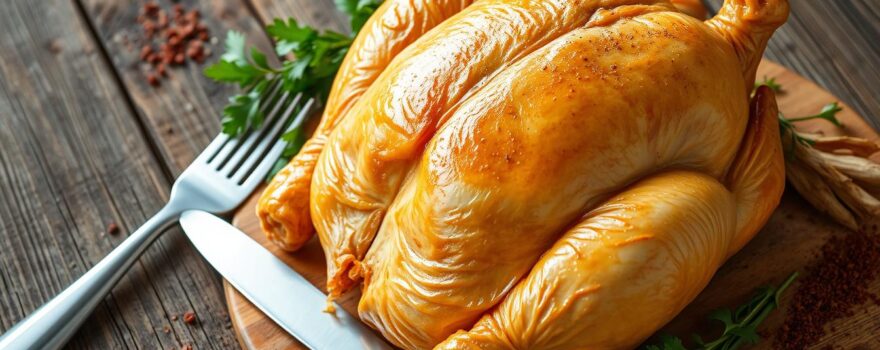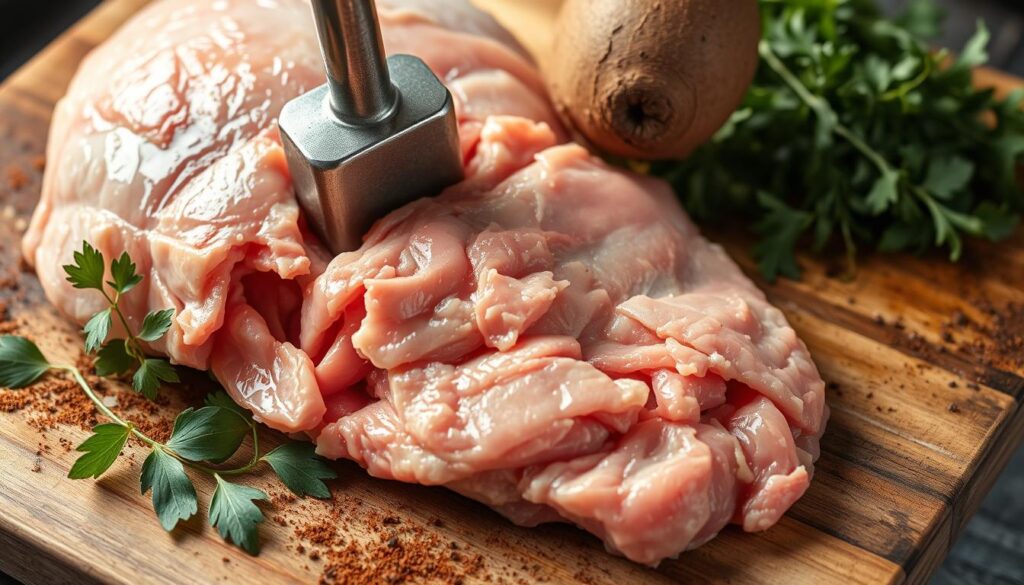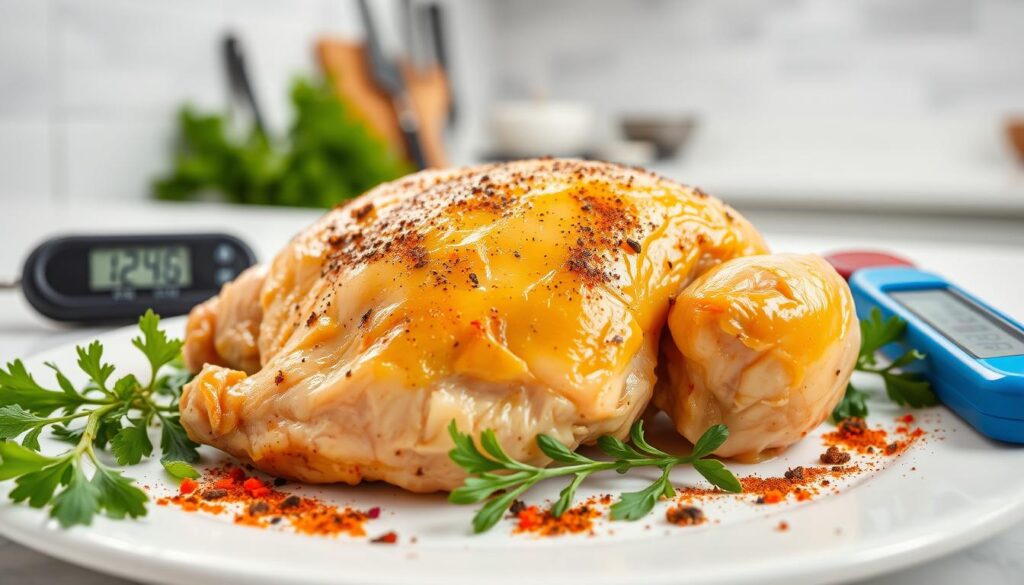
Broiler chicken meat is very popular in the U.S. It’s known for being low in fat, having a mild taste, and being affordable. But, the tenderness of broiler breast meat is a big concern now. This is because more meat is being produced to meet demand.
Things like how long the meat is deboned, the age of the broiler, and how moist it is can affect tenderness. Changes in how the meat is made and processed have made this problem worse. It’s important to keep the meat tender to keep customers happy and loyal to brands.
Key Takeaways
- Proper cooking temperature and resting time are essential for maintaining tenderness in broiler chicken breasts.
- Choosing higher-quality chicken breeds and paying a premium can significantly improve the flavor and texture.
- Marinating chicken in a yogurt or saltwater solution can help tenderize the meat.
- Cooking methods like broiling, stove-top, and grilling offer flexible options for achieving tender, flavorful chicken.
- Electrical stimulation during processing can improve broiler meat tenderness by up to 40%.
Rising Demand for Broiler Chicken Meat
Consumption Trends and Market Growth
Boneless, skinless broiler breast meat is very popular in the U.S. because of its good qualities. As broiler chicken consumption has grown, the poultry industry has changed. Now, it focuses more on further processed poultry products than whole birds.
Broilers are bred for bigger breasts and heavier weights. This makes more meat for processing. But, it can also make the meat less tender.
The poultry market trends show a steady increase in broiler chicken consumption. Chicken meat is now over 90% of the chicken market. It makes up about 28.15% of all meat eaten worldwide.
The fast growth of chicken breast meat is key in the broiler industry today. However, this focus on increased broiler production has brought meat quality issues. Problems like muscle myopathy and abnormalities have appeared.
These issues affect the poultry industry’s growth. Solutions are being looked into to fix these problems. They aim to keep feed efficiency and slaughter performances good.
“Studies have aimed to reduce the occurrence of abnormal broiler meat by adjusting feed formulation and intake. Challenges remain in reducing growth-related abnormalities in broilers without affecting feed efficiency and slaughter performances.”
As broiler chicken consumption keeps growing, the poultry industry must tackle these meat quality issues. It needs to meet the demand for further processed poultry products while keeping meat quality high. Finding a balance between production, processing, and meat quality is key for the industry’s future.
Factors Influencing Broiler Meat Tenderness
Tenderness is key when people buy and eat broiler chicken meat. But, things like deboning time, broiler age, and moisture can make the meat tough. The poultry industry has changed a lot, making these factors even more important for meat quality.
Genetics play a big role in broiler meat quality. Heritability estimates show that genetics can improve meat quality by a lot. Things like sex, age, and diet also affect the color and look of poultry products.
Texture is very important for how people enjoy poultry meat. Water holding capacity affects how firm the meat is. After the bird is killed, rigor mortis can also change how tender the meat is. Things like muscle fiber and environmental stress also play a part.
| Factors Affecting Poultry Meat Quality | Impact on Meat Tenderness |
|---|---|
| Deboning Time | Early deboning (within 2 hours post-mortem) can result in 50-80% of the meat being tough, while waiting 6 hours post-mortem before deboning leads to 70-80% of the poultry meat being tender. |
| Broiler Age | Older broilers tend to have tougher meat due to increased muscle fiber cross-sectional area and connective tissue development. |
| Moisture Content | Higher moisture content in broiler meat can contribute to increased tenderness and juiciness. |
Knowing what affects broiler meat tenderness is key for the poultry industry. It helps them improve the quality and how much people like their products.
The Role of Postmortem Aging
In the broiler chicken industry, aging is key to making meat tender. Traditionally, chickens were deboned 8 to 24 hours after they were killed. This allowed the meat to age properly, making it tender. But, this longer aging time was expensive and cut into processing efficiency.
Recently, aging times have been cut down to meet consumer demand and speed up processing. This makes meat tougher. Deboning too soon, before the meat has fully relaxed, causes the muscle to contract. This makes the meat denser and tougher.
Rigor Mortis and Sarcomere Shortening
Rigor mortis, or the stiffening of muscles after death, affects meat tenderness. After death, the body’s energy runs out, causing muscles to contract. This makes the muscle fibers less flexible and the meat tougher.
The contraction of muscles shortens the sarcomeres, the basic units of muscle. This results in a denser, more compact muscle structure. This makes the meat tougher and less tender.
“Understanding the role of postmortem aging and the impact of rigor mortis and sarcomere shortening is crucial in optimizing broiler chicken meat tenderness.”
Electrical Stimulation: A Solution for Early Deboning
Postmortem electrical stimulation (ES) is a method to make early deboned broiler breast meat tender. It’s a new way to solve the problem of tough meat in early deboned chicken. This technique is promising for improving the tenderness of broiler chicken meat.
ES helps by speeding up rigor mortis, allowing for earlier deboning without making the meat too tough. It can’t stop aging completely, but it shortens the time needed. This makes the meat as tender as if it had aged for 4 to 6 hours, which is easier for businesses to manage.
By combining ES with longer chill times, the meat becomes tender. This makes ES a key tool for better chicken meat tenderness.
There are three main types of electrical stimulation used in the industry:
- Extra low-voltage electrical stimulation (ELVES), carried out at less than 100 V
- Low-voltage electrical stimulation (LVES), between 100-110 V
- High-voltage electrical stimulation (HVES), at more than 110 V
The success of these ES methods depends on several factors. These include the voltage, current, frequency, and duration of the stimulation. The type and placement of electrodes, as well as the time between slaughter and stimulation, also play a role.
“Studies have shown that HVES (550 V) can result in better meat tenderness, color, and leaner meat compared to LVES (150 V) at specific time intervals postmortem.”
The timing of ES is also key. Applying it too early can lead to less tender meat. The best time is right after slaughter or up to 30 minutes later, depending on the study.
In summary, using electrical stimulation wisely, along with other methods, can greatly improve the tenderness of early deboned broiler chicken meat. This makes the meat more appealing to consumers, enhancing its quality and value.
Marination: Enhancing Tenderness and Moisture
Marination is now more common in the poultry world. It helps make broiler breast fillets less tough. Marinades mix water, salt, phosphate, and more to make meat tender and hold water better.
Research shows marination makes poultry meat taste better. Scientists have looked into how long to marinate and the effect of pH. They’ve also tested using ultrasound for better results.
Marination works by changing the meat’s pH with acidic or alkaline solutions. Acidic marinades, like traditional ones, cut down on harmful compounds. Alkaline marinades use sodium bicarbonate and other ingredients to improve tenderness and moisture.
What’s in the marinade matters a lot. Acids, enzymes, and physical methods help with tenderness, flavor, and shelf life. Yogurt, kefir, chili, garlic, turmeric, and ginger are popular choices. Polyphenols and antioxidants add extra benefits.
How well marination works depends on several things. These include deboning times, how long meat is marinated, and the marinade itself. By tweaking these factors, the poultry industry can make broiler chicken meat more tender and moist.
“Marination has shown a significant improvement in the tenderness and moisture of broiler chicken meat.”
How to Improve the Tenderness of Broiler Chicken Meat
Best Practices and Techniques
Making broiler chicken meat tender and juicy is key for both processors and consumers. Luckily, there are several effective methods to achieve this goal.
Electrical stimulation is one such method. It helps speed up the meat’s firmness development, allowing for earlier deboning. This way, the meat stays tender and juicy.
Marination is another great technique. Adding a marinade with water, salt, and phosphates can greatly enhance the meat’s texture and juiciness. Retail and foodservice often use a 12% to 15% marinade for their broiler breast fillets.
Lastly, postmortem aging is important, even if it’s shorter than the traditional 4-6 hours. Proper aging time is essential for tenderizing the meat, ensuring high-quality broiler chicken products.
Using these techniques together, processors can consistently offer tender, juicy, and flavorful broiler chicken meat. This meets the needs of today’s health-conscious consumers.

Quality Control and Consumer Acceptance
Keeping broiler meat quality consistent is key to pleasing customers and keeping their loyalty. Different bird ages, shorter aging times, and tenderizing methods can cause quality issues. If meat is tough or uneven, it can hurt brand loyalty.
The poultry industry needs a strong quality control plan. This plan should keep broiler breast meat tender and tasty. This is vital for making customers happy.
Things that affect broiler meat quality and how customers feel include:
- Product Consistency: It’s important to have the same tenderness, texture, and taste in all broiler chicken. This builds trust and loyalty with customers.
- Broiler Meat Quality Control: Strict quality checks, like watching aging times and tenderizing methods, help keep meat quality steady.
- Consumer Satisfaction: Knowing what customers want in tender, tasty broiler meat is crucial for keeping them happy and coming back.
By focusing on these areas, the poultry industry can improve the quality and consistency of broiler chicken. This leads to happier customers and stronger brand loyalty.
“Providing consistently high-quality broiler meat is essential for maintaining strong consumer relationships and brand trust in the poultry industry.”
Nutritional and Management Factors
Influence of Diet and Rearing Conditions
The quality and safety of broiler chicken meat depend on their diet and how they are raised. The type of fatty acids in their food and the environment they live in affect the meat’s tenderness, flavor, and juiciness.
A recent study found that the diet of Beijing-You Chicken, a slow-growing breed, impacts growth and meat quality. Birds fed 16.0% and 17.0% crude protein (CP) did better than those fed 18.0% CP. They gained more weight and ate more feed.
Good nutrition, management, and genetics are key to high-quality meat. Animals need diets that help them hold water well, reduce oxidative stress, and boost antioxidants. This ensures the meat is tender, flavorful, and juicy.
| Metric | Findings |
|---|---|
| Growth Performance | Improved average feed intake and body weight gain in 16.0% and 17.0% CP groups compared to 18.0% CP group |
| Slaughter Performance | Dressed weight, half-eviscerated weight with giblet, eviscerated weight, breast muscle yield, and leg muscle yield were measured |
| Meat Quality | pH24h, shear force, drip loss, and cooking loss measurements on breast muscle samples |
| Myofiber Characteristics | Myofiber diameter, myofiber density, number of fibers in muscle bundle, endomysium thickness, and perimysium thickness were analyzed |
The rearing environment also affects broiler meat quality. For example, breast meat from birds processed at 42 days had lower water-holding capacity than those processed at 53 days. Sex differences were also found, with females having lower pH values and higher color values than males.
By managing broiler nutrition and rearing practices well, producers can improve the meat’s tenderness, flavor, and quality. This meets the growing demand for high-quality broiler products.
Food Safety and Microbial Considerations
In the world of broiler chicken meat, keeping food safe is top priority. It’s all about quality and stopping germs to protect people and follow rules. Broiler meat food safety, microbial contamination, pathogen control, and processing hygiene are key to making sure the meat is safe and healthy.
Foodborne pathogens like Salmonella need careful handling. Good pathogen control and clean practices can lower germ risks. This makes the meat safer for everyone.
Keeping the gut healthy is also vital for broiler meat food safety. Using probiotics, prebiotics, or tannins can help. They improve how the birds digest food and fight off bad bacteria.
| Microbial Considerations | Key Strategies |
|---|---|
| Salmonella Control | Improved sanitation, dietary interventions |
| Gut Health Optimization | Probiotics, prebiotics, tannin-based supplements |
| Processing Hygiene | Stringent cleaning, disinfection, and monitoring |
Keeping the processing area clean is also crucial. Clean, disinfect, and watch closely to avoid germs. These steps help keep the meat safe and meet high standards of broiler meat food safety.

“Maintaining the highest levels of food safety and quality is a non-negotiable imperative in the modern poultry industry. By proactively addressing microbial considerations, we can ensure the delivery of safe, wholesome broiler meat to consumers worldwide.”
Conclusion
Keeping broiler chicken meat tender is a big challenge for the poultry industry. It has grown to meet market needs. Techniques like electrical stimulation, marination, and postmortem aging help make meat tender. These methods also improve the taste and texture of broiler meat.
Broiler nutrition, rearing conditions, and food safety are also key. They ensure the quality and safety of broiler chicken meat. These factors are crucial for the meat’s overall quality and acceptability.
Improving broiler meat quality is vital for the poultry industry’s growth. As poultry demand increases, the industry must focus on quality. Adopting best practices is essential to meet consumer expectations.
This focus on quality will shape the future of the poultry industry. By prioritizing tenderness and quality, the industry can thrive. It will meet the changing needs of the market.
A comprehensive approach is needed. It should address genetic, processing, and management factors. This will ensure a sustainable and successful future for the industry. It will solidify its role as a key provider of nutritious and tasty broiler chicken meat.